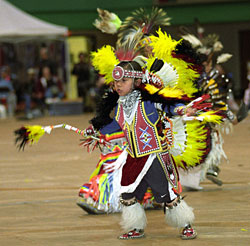Nearly every federal policy directed toward Native Americans since the time of America’s discovery has been a policy of either annihilation or assimilation.
For this reason, Native Americans have not been fully recognized as vibrant, valued and productive, says Dana Klar, J.D., founding and interim director of the Kathryn M. Buder Center for American Indian Studies at Washington University in St. Louis.
“Our government has sent the message, ‘We’ve been able to assimilate you. Why separate you?'”

Native American efforts to preserve and promote a treasured culture have taken many forms, including powwow ceremonies.
This paradox, says Klar, helps to explain why Native American Indian Heritage month, which began Nov. 1, often comes and goes with very little fanfare.
“There hasn’t been a voice from either side saying, ‘Let’s make this a national recognition. It’s been quiet,” she adds.
The reasons for the silence range from history book lessons to census reports to lack of individual leadership.
“If you look at what our school children are being taught, it’s the American Indian was. The American Indian is history,” Klar says. “There is very little being taught on contemporary American Indian issues in the forefront of American society.”
Walking in two worlds
According to the 2000 census, Native Americans make up between 2 and 3 percent of the U.S. population. That fact undeniably contributes to their low profile, acknowledged Klar, a member of the United Houma Nation.
But that sliver of the American pie, which includes Alaska natives, comprises approximately 600 distinct nations with different sovereignties and languages. While the nations represent a rich abundance of cultural diversity, there is a glaring absence in their midst: “a united voice to move them forward,” Klar says.
“Because tribal leadership is often communal,” she notes, “it is less recognized by the mainstream.”

Dana Klar, J.D.
Identity issues among this group are problematic, too. More than two-thirds of the American Indian population lives in urban areas. “They are a bicultural people who have a heritage connected to traditional communities,” says Klar. “They have different value sets, different ways of looking at the world and different ways of adapting. They walk in two worlds.
“To recognize that duality and bring understanding into a more contemporary world for our youth is critical,” she added.
That may not, however, be enough, Klar says. Society must do away with offensive stereotypes and caricatures that have distorted and diminished the Native American identity. “The portrayal of the lazy Indian and the drunken Indian runs contrary to what actual native communities are like,” she says.
Moreover, the use of Indian symbols and mascots by sports teams echoes a colonial mindset insulting to Native peoples. While this insensitivity has been addressed by many organizations, the Atlanta Braves still brandish their tomahawk chop. As for the Washington Redskins’ mascot, Klar points out that “Redskins” once referred to Indian slaves on slave-trading blocks.
Promoting a treasured culture
Native American efforts to preserve and promote a treasured culture have taken many forms. Powwow ceremonies are held to celebrate a good harvest, honor religious beliefs and bring about healing. Festivals saluting tribal heritage have been popular, too.
Perhaps most important are the efforts of political and social organizations such as the National Congress of American Indians, Native American Rights Fund, and most recently, the Indigenous Democratic Network, known as INDN’s List.
Launched in 2005 to help elect Indians to public office, this grassroots organization was instrumental in bringing 16 INDN candidates to victory early this week in state legislatures across the nation.
Also influential is the work of native researchers, Klar says. At the Buder Center, located in Washington University’s George Warren Brown School of Social Work, scholars study topics ranging from diabetes management to asset-building strategies.
Supported by the Buder Foundation, these scholars are required, upon graduation, to return to their communities for a time to make contributions as well-trained professionals.
Alumni lead tribal councils, build health clinics and hold posts in higher education.
“Putting M.S.W.s and Ph.D.s into native communities is one way to value and promote native culture,” Klar says. “It underscores the idea that this is a history that should not be wiped off the face of the earth.”
This scholarly work also can produce significant project funding from foundations and agencies instrumental in effecting social change.
“Native communities are realizing that we need education to keep moving forward,” Klar adds. “Through education, dedicated research and political efforts, we are beginning to strengthen representation in tribal, state and federal governments.
“It is through such representation that more recognition can begin.”